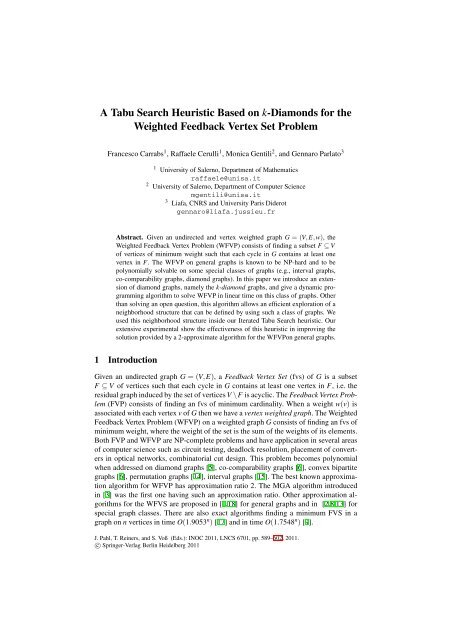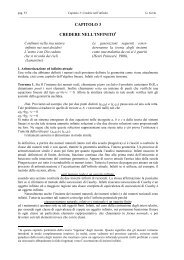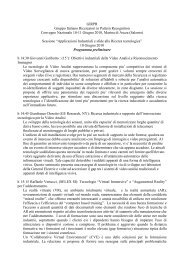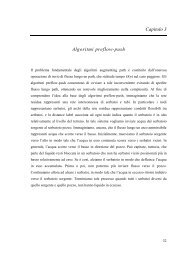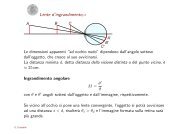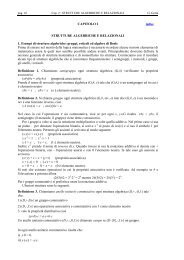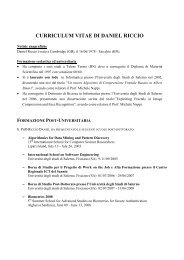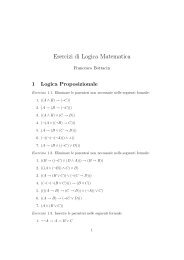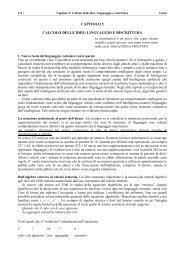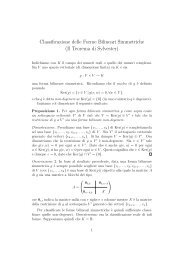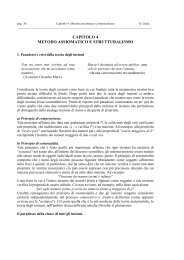A Tabu Search Heuristic Based on k-Diamonds for ... - ePrints Soton
A Tabu Search Heuristic Based on k-Diamonds for ... - ePrints Soton
A Tabu Search Heuristic Based on k-Diamonds for ... - ePrints Soton
You also want an ePaper? Increase the reach of your titles
YUMPU automatically turns print PDFs into web optimized ePapers that Google loves.
A <str<strong>on</strong>g>Tabu</str<strong>on</strong>g> <str<strong>on</strong>g>Search</str<strong>on</strong>g> <str<strong>on</strong>g>Heuristic</str<strong>on</strong>g> <str<strong>on</strong>g>Based</str<strong>on</strong>g> <strong>on</strong> k-Diam<strong>on</strong>ds <strong>for</strong> theWeighted Feedback Vertex Set ProblemFrancesco Carrabs 1 , Raffaele Cerulli 1 , M<strong>on</strong>ica Gentili 2 , and Gennaro Parlato 31 University of Salerno, Department of Mathematicsraffaele@unisa.it2 University of Salerno, Department of Computer Sciencemgentili@unisa.it3 Liafa, CNRS and University Paris Diderotgennaro@liafa.jussieu.frAbstract. Given an undirected and vertex weighted graph G =(V,E,w), theWeighted Feedback Vertex Problem (WFVP) c<strong>on</strong>sists of finding a subset F ⊆ Vof vertices of minimum weight such that each cycle in G c<strong>on</strong>tains at least <strong>on</strong>evertex in F. The WFVP <strong>on</strong> general graphs is known to be NP-hard and to bepolynomially solvable <strong>on</strong> some special classes of graphs (e.g., interval graphs,co-comparability graphs, diam<strong>on</strong>d graphs). In this paper we introduce an extensi<strong>on</strong>of diam<strong>on</strong>d graphs, namely the k-diam<strong>on</strong>d graphs, and give a dynamic programmingalgorithm to solve WFVP in linear time <strong>on</strong> this class of graphs. Otherthan solving an open questi<strong>on</strong>, this algorithm allows an efficient explorati<strong>on</strong> of aneighborhood structure that can be defined by using such a class of graphs. Weused this neighborhood structure inside our Iterated <str<strong>on</strong>g>Tabu</str<strong>on</strong>g> <str<strong>on</strong>g>Search</str<strong>on</strong>g> heuristic. Ourextensive experimental show the effectiveness of this heuristic in improving thesoluti<strong>on</strong> provided by a 2-approximate algorithm <strong>for</strong> the WFVP<strong>on</strong> general graphs.1 Introducti<strong>on</strong>Given an undirected graph G =(V,E), aFeedback Vertex Set (fvs) of G is a subsetF ⊆ V of vertices such that each cycle in G c<strong>on</strong>tains at least <strong>on</strong>e vertex in F, i.e.theresidual graph induced by the set of vertices V \F is acyclic. The Feedback Vertex Problem(FVP) c<strong>on</strong>sists of finding an fvs of minimum cardinality. When a weight w(v) isassociated with each vertex v of G then we have a vertex weighted graph. The WeightedFeedback Vertex Problem (WFVP) <strong>on</strong> a weighted graph G c<strong>on</strong>sists of finding an fvs ofminimum weight, where the weight of the set is the sum of the weights of its elements.Both FVP and WFVP are NP-complete problems and have applicati<strong>on</strong> in several areasof computer science such as circuit testing, deadlock resoluti<strong>on</strong>, placement of c<strong>on</strong>vertersin optical networks, combinatorial cut design. This problem becomes polynomialwhen addressed <strong>on</strong> diam<strong>on</strong>d graphs [5], co-comparability graphs [6], c<strong>on</strong>vex bipartitegraphs [6], permutati<strong>on</strong> graphs [14], interval graphs [15]. The best known approximati<strong>on</strong>algorithm <strong>for</strong> WFVP has approximati<strong>on</strong> ratio 2. The MGA algorithm introducedin [3] was the first <strong>on</strong>e having such an approximati<strong>on</strong> ratio. Other approximati<strong>on</strong> algorithms<strong>for</strong> the WFVS are proposed in [1,18] <strong>for</strong> general graphs and in [2,8,13] <strong>for</strong>special graph classes. There are also exact algorithms finding a minimum FVS in agraph <strong>on</strong> n vertices in time O(1.9053 n ) [17] and in time O(1.7548 n ) [9].J. Pahl, T. Reiners, and S. Voß (Eds.): INOC 2011, LNCS 6701, pp. 589–602, 2011.c○ Springer-Verlag Berlin Heidelberg 2011
590 F. Carrabs et al.In this paper we focus <strong>on</strong> the weighted feedback vertex set problem (WFVP). In particular,we introduce an extensi<strong>on</strong> of diam<strong>on</strong>d graphs, namely the k-diam<strong>on</strong>d graphs,and give a linear time algorithm to solve WFVP <strong>on</strong> it based <strong>on</strong> a dynamic programmingapproach. Moreover, we show how this new class of graphs can be used to definea neighborhood structure (namely, the k-diam<strong>on</strong>d Neighborhood) of a given feasiblesoluti<strong>on</strong> and, successively, we show how to solve the problem <strong>on</strong> general graphs bymeans of a tabu search technique using the k-diam<strong>on</strong>d neighborhood. Such a classof neighborhood was already introduced in [4], where, however, the computati<strong>on</strong>alcomplexity of finding an optimum WFVP <strong>on</strong> a k-diam<strong>on</strong>d graph was left open anda heuristic approach was used to solve the problem. We solve such an open problem(by giving a linear time algorithm) and also show the effectiveness of the chosen neighborhoodin improving a given initial feasible soluti<strong>on</strong> when explored by means of ourexplorati<strong>on</strong> strategy. In order to do this, experimental results are given to show howour Iterative <str<strong>on</strong>g>Tabu</str<strong>on</strong>g> <str<strong>on</strong>g>Search</str<strong>on</strong>g> can improve the initial feasible soluti<strong>on</strong>, returned by the 2-approximate MGA algorithm [3], when the k-diam<strong>on</strong>d neighborhood is defined and efficientlyexplored.The sequel of the paper is organized as follows. Secti<strong>on</strong> 2 introduces the basic notati<strong>on</strong>.Secti<strong>on</strong> 3 describes the class of k-diam<strong>on</strong>d graphs and c<strong>on</strong>tains the main propertiesto solve WFVP in linear time <strong>on</strong> this class. The role of k-diam<strong>on</strong>ds to define a neighborhoodstructure is described in Secti<strong>on</strong> 4, together with the proposed Iterated <str<strong>on</strong>g>Tabu</str<strong>on</strong>g><str<strong>on</strong>g>Search</str<strong>on</strong>g> heuristic. Computati<strong>on</strong>al results are reported in Secti<strong>on</strong> 5. Finally, c<strong>on</strong>cludingremarks are discussed in Secti<strong>on</strong> 6.2 Definiti<strong>on</strong>s and Notati<strong>on</strong>Let G =(V,E,w) be an undirected and vertex weighted graph, where V is the set of nvertices, E is the set of m edges, and, w(v) is a positive weight associated with eachvertex v ∈ V. Given a subset X ⊆ V of vertices, let us define its weight W(X) as the sumof the weights of its elements, i.e. W(X)=∑ v∈X w(v) and ¯X = V \ X its complementaryset. If X = /0 thenW(X)=0. We denote by G[X] the subgraph of G induced by the setof vertices X ⊆ V . Formally, G[X]=(X,E [X] ,w) where E [X] = {(x,y) ∈ E : x,y ∈ X}.Atree T r rooted in r is an acyclic and c<strong>on</strong>nected graph. We define a <strong>for</strong>est F as a graphwhere any c<strong>on</strong>nected comp<strong>on</strong>ent is a tree. A subset of vertices X is a feedback vertexset of G if and <strong>on</strong>ly if G[ ¯X] is a <strong>for</strong>est. From now <strong>on</strong> we denote by F(G) and F ∗ (G),any feedback vertex set and the minimum weight feedback vertex set of G, respectively.When no c<strong>on</strong>fusi<strong>on</strong> may arise we simply denote these sets by F and F ∗ respectively.Moreover, we define F¯v a feedback vertex set of G not c<strong>on</strong>taining vertex v. Avertexv ∈ F is redundant if and <strong>on</strong>ly if F \{v} is a feedback vertex set of G.Anyvertexv ∈ Vis said to be appended if it is not included in any cycle of G. Obviously, a set of verticesis an fvs of G if and <strong>on</strong>ly if it is an fvs of the graph G ′ obtained from G after deletingall the appended vertices. We say a graph is reduced if it does not c<strong>on</strong>tain any appendedvertex. The reducti<strong>on</strong> operati<strong>on</strong> of a graph can be per<strong>for</strong>med in linear time. W.l.o.g.,from now <strong>on</strong> we suppose graph G to be a reduced graph. For any additi<strong>on</strong>al definiti<strong>on</strong>and notati<strong>on</strong> we refer to [7].
<str<strong>on</strong>g>Tabu</str<strong>on</strong>g> <str<strong>on</strong>g>Search</str<strong>on</strong>g> to Solve the Weighted Feedback Vertex Set Problem 59111814232 3 491015 1645 65 6 7 11 12 1317 187 8 91019(a)(b)Fig. 1. (a) A diam<strong>on</strong>d with upper apex r = 1 and lower apex z = 10. (b)A3-diam<strong>on</strong>d with upperapices R = {1,8,14} and lower apex z = 19. Note that, as stated by property 1, it is composed bythe three diam<strong>on</strong>ds D 1 ,D 8 and D 14 .3 The Classofk-Diam<strong>on</strong>d GraphsIn this secti<strong>on</strong> we first recall the definiti<strong>on</strong> of the class of diam<strong>on</strong>d graphs introducedin [5], and successively we <strong>for</strong>mally describe the extended class of k-diam<strong>on</strong>d graphs.Then, we prove the basic properties that are useful to optimally solve WFVP <strong>on</strong> thisnew class in linear time.A weighted diam<strong>on</strong>d D r,z =(V r ,E r ,w) is an undirected and vertex weighted graphwhere (i) each vertex v ∈ V r is included in at least <strong>on</strong>e simple path between r and z and(ii) D r,z [¯z] is a tree. The two vertices r and z are called the upper and lower apex of adiam<strong>on</strong>d D r,z , respectively, and, the subgraph D r,z [¯z] is referred to as the tree T r rooted inr associated with D r,z . In Figure 1(a) the diam<strong>on</strong>d D 1,10 with upper apex r = 1andlowerapex z = 10 is shown. Note that by deleting vertex z we obtain the tree T 1 = D 1,10 [ 10]. ¯As shown in [5], WFVP can be solved in linear time <strong>on</strong> a diam<strong>on</strong>d graph by a dynamicprogramming algorithm. Let us refer to such an algorithm as DP. In the sequelwe show how to use DP to solve WFVP in linear time <strong>on</strong> a k-diam<strong>on</strong>d. A k-diam<strong>on</strong>d isa generalizati<strong>on</strong> of a diam<strong>on</strong>d where multiple upper apices are allowed, <strong>for</strong>mally:Definiti<strong>on</strong> 1. A weighted k-diam<strong>on</strong>d D R,z =(V R ,E R ,w), wherek≥ 1,R= {r 1 ,r 2 ,...,r k }⊆V R and z ∈ V R , is an undirected and vertex weighted graph where (i) each vertexv ∈ V R is included in a simple path between exactly <strong>on</strong>e of the k apices r i ∈ R and z and(ii) D R,z [¯z] is a <strong>for</strong>est with k c<strong>on</strong>nected comp<strong>on</strong>ents.Following the definiti<strong>on</strong> introduced <strong>for</strong> diam<strong>on</strong>d graphs, we refer to the set of vertices Rand to vertex z of D R,z as the set of upper apices and the lower apex of D R,z , respectively.The subgraph D R,z [¯z] is referred to as the <strong>for</strong>est F R , associated with D R,z , whose c<strong>on</strong>nectedcomp<strong>on</strong>ents are the k trees T ri rooted in r i ∈ R. Figure 1(b) shows a 3-diam<strong>on</strong>d.The set of upper apices is composed of the three vertices R = {1,8,14}, while the lowerapex is vertex z = 19. The graph obtained from D R,z , after deleting the lower apex, is a<strong>for</strong>est with the three c<strong>on</strong>nected comp<strong>on</strong>ents T 1 , T 8 and T 14 . To keep notati<strong>on</strong> simple, inthe sequel of the paper and when no c<strong>on</strong>fusi<strong>on</strong> may arise, we denote a k-diam<strong>on</strong>d D R,z ,
592 F. Carrabs et al.with R = {r 1 ,...,r k },justbyD R and a diam<strong>on</strong>d graph D r,z by D r . Note that <strong>for</strong> k = 1ak-diam<strong>on</strong>d is a diam<strong>on</strong>d. Moreover, it is easy to see that the following property holds:Property 1 (Decompositi<strong>on</strong>). Any k-diam<strong>on</strong>d D R is composed by k distinct diam<strong>on</strong>dsD ri , with r i ∈ R, having all the same lower apex z.For instance, the 3-diam<strong>on</strong>d depicted in Figure 1(b) is composed by three diam<strong>on</strong>dsD 1 , D 8 and D 14 . We will see in the following how to use the decompositi<strong>on</strong> propertyto solve WFVP <strong>on</strong> D R . By definiti<strong>on</strong> of k-diam<strong>on</strong>d, the following properties obviouslyhold.Property 2. The singlet<strong>on</strong> {z} is an fvs of D R .Property 3. Every cycle of D R c<strong>on</strong>tains vertex z and vertices bel<strong>on</strong>ging to the samec<strong>on</strong>nected comp<strong>on</strong>ent of F R .Observe that, by property 2, a minimum weight feedback vertex set F ∗ (D R ) of D Reither c<strong>on</strong>tains vertex z or not. There<strong>for</strong>e, to find F ∗ (D R ) we can proceed as follows:(i) compute the minimum weight feedback vertex set F ∗¯z (D R ) that does not c<strong>on</strong>tainz; (ii) if W(F ∗¯z (D R)) < w(z) then set F ∗ (D R )=F ∗¯z (D R) otherwise set F ∗ (D R )={z}.The computati<strong>on</strong> of F ∗¯z (D R) can be carried out by finding the fvs F ∗ (D Ri ) of minimumweight <strong>on</strong> each of the k diam<strong>on</strong>ds D ri that compose D R as proven by the followinglemma:Lemma 1. Given the k-diam<strong>on</strong>d D R ,letF ∗¯z (D ri ), ∀r i ∈ R, be a minimum weight feedbackvertex set of diam<strong>on</strong>d D ri not c<strong>on</strong>taining vertex z. Then: F ∗¯z (D R)= ⋃F ∗¯z (D r i).Proof. Let X = ⋃ r i ∈R F ∗¯z (D r i). We need to prove that X is a minimum fvs of D R notc<strong>on</strong>taining z,i.e.X = F ∗¯z (D R ). From property 3 and by definiti<strong>on</strong> of F ∗¯z (D ri ), it is evidentthat X is an fvs of D R there<strong>for</strong>e we have <strong>on</strong>ly to prove that X is minimum. Let ussuppose, by c<strong>on</strong>tradicti<strong>on</strong>, there exists another fvs, say Y, such that z /∈ Y and W(Y )
<str<strong>on</strong>g>Tabu</str<strong>on</strong>g> <str<strong>on</strong>g>Search</str<strong>on</strong>g> to Solve the Weighted Feedback Vertex Set Problem 593Procedure: DP multiStep 1. <strong>for</strong> all D ri compute Fz ∗(Dr i);Step 2. Set Fz ∗ (D R) ← ⋃Fz ∗ (D r i);r i ∈RStep 3. if W (Fz ∗(DR)) < w(z) then F ∗ (D R ) ← Fz ∗(DR) otherwise F ∗ (D R ) ←{z};Step 4. Return F ∗ (D R );Fig. 2. Pseudo code of algorithm DP multitotal cost of step 1 is equal to O(|V R |) time. The joining operati<strong>on</strong> carried out at step 2requires O(k) time, while step 3 and step 4 require c<strong>on</strong>stant time. C<strong>on</strong>sequently, DP multiruns in O(|V R |) time.⊓⊔The next secti<strong>on</strong>s c<strong>on</strong>tain a descripti<strong>on</strong> of a general neighborhood structure based <strong>on</strong>the class of k-diam<strong>on</strong>ds and introduce an operator that, using DP multi , efficiently exploressuch a neighborhood. This operator will be later embedded into our Iterated<str<strong>on</strong>g>Tabu</str<strong>on</strong>g> <str<strong>on</strong>g>Search</str<strong>on</strong>g>.4 The Neighborhood Structures and the Iterative <str<strong>on</strong>g>Tabu</str<strong>on</strong>g> <str<strong>on</strong>g>Search</str<strong>on</strong>g>The basic paradigm of tabu search is to use in<strong>for</strong>mati<strong>on</strong> about the search history to guidelocal search approaches to overcome local optimality. <str<strong>on</strong>g>Based</str<strong>on</strong>g> <strong>on</strong> some sort of memorycertain moves may be <strong>for</strong>bidden, we say they are set tabu (and appropriate move attributesare put into a list, the so-called tabu list). The search may imply acceptancedeteriorating moves when no improving moves exist or all improving moves of thecurrent neighborhood are set tabu. We implemented an extensi<strong>on</strong> of the standard <str<strong>on</strong>g>Tabu</str<strong>on</strong>g><str<strong>on</strong>g>Search</str<strong>on</strong>g> [10,11,12] (TS), namely the Iterated <str<strong>on</strong>g>Tabu</str<strong>on</strong>g> <str<strong>on</strong>g>Search</str<strong>on</strong>g> [16] (ITS), whose central ideais based <strong>on</strong> the c<strong>on</strong>cept of intensificati<strong>on</strong> and diversificati<strong>on</strong>. The intensificati<strong>on</strong> phaseis focused in finding a better (locally optimal) soluti<strong>on</strong> in “surroundings”, i.e. neighborhood,of the current soluti<strong>on</strong>. The ITS method uses the classical TS to achieve such animprovement. The Diversificati<strong>on</strong> phase is used whenever the tabu memory indicatesthat <strong>on</strong>e is trapped in a certain basin of attracti<strong>on</strong> and then allows to escape from thecurrent local optimum and to move towards new regi<strong>on</strong>s in the soluti<strong>on</strong> space.In the following subsecti<strong>on</strong>s the main comp<strong>on</strong>ents of the algorithm are described: (i)the neighborhood structures (namely, the k-diam<strong>on</strong>d neighborhood and the 2-exchangeneighborhood),(ii) the corresp<strong>on</strong>ding explorati<strong>on</strong> strategies (namely, the Single−Insertand the Double − Insert operators, respectively); (iii) the tabu list and (iv) the diversificati<strong>on</strong>phase. The pseudo-code of our Iterative <str<strong>on</strong>g>Tabu</str<strong>on</strong>g> <str<strong>on</strong>g>Search</str<strong>on</strong>g> (ITS) is given in Fig. 5.4.1 The k-Diam<strong>on</strong>d NeighborhoodGiven a graph G, letF be any not redundant fvs of G and F = G[ ¯F] the <strong>for</strong>est inducedby vertices not in F. By inserting a vertex z ∈ F in F a k-diam<strong>on</strong>d D R is obtained. Let I z
594 F. Carrabs et al.be an fvs of D R not c<strong>on</strong>taining z, then the set F ′ = I z ∪{F \{z}} is a new fvs of G.Notethat, F ′ could c<strong>on</strong>tain redundant vertices. Let O z be the set of the redundant vertices ofF ′ . Note that, by c<strong>on</strong>structi<strong>on</strong> of I z ,wehaveO z ⊆ F \{z}.Addz to O z and c<strong>on</strong>sider thevertex set F new = I z ∪{F \ O z }. F new is a not redundant fvs of G and: if W (I z ) < W (O z ),its weight is lower than the weight of F. Given a vertex z ∈ F, we define the couple(I z ,O z ) an exchange set of z, <strong>for</strong>mally:Definiti<strong>on</strong> 2. Given a vertex z ∈ F, the couple (I z ,O z ),whereI z ⊆ V \ F, O z ⊆ F andz ∈ O z , is a exchange set of z if the set I z ∪{F \ O z } is a not redundant fvs of G.Let us denote by E (F,z) the collecti<strong>on</strong> of all the exchange sets associated with z ∈F, i.e.E (F,z) = { (I z ,O z ) : I z ∪{F \ O z } is a not reduntant fvs of G } .Thek-diam<strong>on</strong>dneighborhood is defined as follows:Definiti<strong>on</strong> 3. Given a graph G and an fvs F, the k-diam<strong>on</strong>d neighborhood N (F) isthe set of all not redundant fvs of G that can be obtained from F through the exchangesets associated with each vertex z ∈ F:{}N (F)= I z ∪{F \ O z } : (I z ,O z ) ∈ E (F,z),∀z ∈ FNote that, given a vertex z ∈ F, finding the minimum cost set I z associated with it corresp<strong>on</strong>dsto find the minimum weight feedback vertex set <strong>on</strong> the k-diam<strong>on</strong>d associatedwith z. Hence, by applying the DP multi algorithm we can per<strong>for</strong>m an implicit exhaustiveexplorati<strong>on</strong> <strong>on</strong> the neighborhood to find a local optimum in polynomial time. Thisexplorati<strong>on</strong> is carried out by our first operator Single − Insert that is described next.The Single − Insert Operator Given a not redundant fvs F of G and the incumbentsoluti<strong>on</strong> F ∗ ,theSingle − Insert operator builds, <strong>for</strong> each z ∈ F, thek-diam<strong>on</strong>dD R by introducing z in F = G[ ¯F]. Successively, it computes an exchange set (I z ,O z )where I z = F ∗¯z (D R), i.eI z is the minimum feedback vertex set of D R not c<strong>on</strong>tainingz. The operator selects the best exchange set (I ∗ z ,O∗ z ) such that W(I∗ z ) − W(O∗ z )=min (Iz ,O z ):z∈F{W(I z ) − W(O z )}. More in detail (see Fig. 3), the operator builds the k-diam<strong>on</strong>d D R (step 1), finds the fvs F ∗¯z (D R) by applying algorithm DP multi and setsI z ← F ∗¯z (D R) (step 2). The operator (step 3) finds redundant vertices (if any) of thenew fvs F new = F \{z}∪{I z } to be inserted in O z (initially O z = {z}). To this end,Single − Insert builds the <strong>for</strong>est F ′ = G[ ¯F new ] and reintroduces, <strong>on</strong>e by <strong>on</strong>e, each vertexz ′ ∈ F \{z} to check whether z ′ is redundant or not. If z ′ is redundant then it ismoved from F new to O z .ThefinalfvsF new = I z ∪{F \ O z } is then obtained after all thevertices in F \{z} are checked <strong>for</strong> redundancy. Note that the pair (I z ,O z ) is the movecorresp<strong>on</strong>ding to the transiti<strong>on</strong> from soluti<strong>on</strong> F to its neighbor F new .The weight of the new set F new is then compared with the weight of the incumbentsoluti<strong>on</strong> F ∗ found so far. If W(F new ) < W(F ∗ ), then the operator sets the best move(I ∗ z ,O ∗ z ) equal to (I z ,O z ) even if this move is tabu (this represents the applicati<strong>on</strong> ofan aspirati<strong>on</strong> criteri<strong>on</strong> [12]). Otherwise, if (I z ,O z ) is not tabu and the corresp<strong>on</strong>dingsoluti<strong>on</strong> is better than the soluti<strong>on</strong> associated with (I ∗ z ,O ∗ z ), the algorithm sets (I ∗ z ,O ∗ z )equal to (I z ,O z ). Finally, if both previous cases do not hold, (I z ,O z ) is neglected.
<str<strong>on</strong>g>Tabu</str<strong>on</strong>g> <str<strong>on</strong>g>Search</str<strong>on</strong>g> to Solve the Weighted Feedback Vertex Set Problem 595Procedure: Single − Insert(G,F, F ∗ )Set W (I ∗ z ) ← ∞, W (O∗ z ) ← 0<strong>for</strong> all z ∈ F doStep 1. Insertz in G[ ¯F] and reduce the obtained graph to produce the k-diam<strong>on</strong>d D R ;Step 2. SetI z ← F ∗¯z (D R);Step 3. Find the set of redundant nodes O z ,addz to O z ,andsetF new ← I z ∪{F \ O z };Step 4. if W (F new ) < W (F ∗ ) do // aspirati<strong>on</strong> criteri<strong>on</strong> //I ∗ z ← I z ,O ∗ z ← O z ;else if W (I z ) −W (O z ) < W(I ∗ z ) −W (O ∗ z ) and (I z ,O z ) is not tabu doI ∗ z ← I z,O ∗ z ← O z;end <strong>for</strong>return (I ∗ z ∪{F \ O∗ z }); Fig. 3. Pseudo-code of operator Single − Insert4.2 The 2-Exchange Neighborhood and the Double − Insert OperatorAdditi<strong>on</strong>al neighborhoods similar to the k-diam<strong>on</strong>d neighborhood above described canbe c<strong>on</strong>sidered if more than <strong>on</strong>e vertex of F is selected to be introduced in F = G[ ¯F].Indeed, a drawback of the Single − Insert operator c<strong>on</strong>cerns the diversificati<strong>on</strong> of theexplored soluti<strong>on</strong>s. In fact, when there are not redundant vertices, <strong>on</strong>ly <strong>on</strong>e vertex (thelower apex z) is moved from F to F = G[ ¯F]. Hence, in the worst case, several applicati<strong>on</strong>sof the operator Single − Insert are necessary to remove more than <strong>on</strong>e vertexfrom F. In order to overcome this issue, we c<strong>on</strong>sider a new neighborhood, namely the2-exchange neighborhood, to diversify the explored soluti<strong>on</strong>s, that is, we c<strong>on</strong>sidered thecase when two vertices {z i ,z j } are selected to be inserted in F . This neighborhood isexplored by the operator Double − Insert (see Fig. 4) that differs from Single − Insertsince it inserts two lower apices {z i ,z j } into F , and finds the fvs I zi ,z jby applying algorithmMGA. MGA is a greedy algorithm that selects at each iterati<strong>on</strong> the vertex v suchthat the ratio w(v)/d(v) is minimum, where d(v) is the degree of the vertex. When avertex is selected, it is removed from G and G is then reduced to obtain the subgraph G ′ .The degree of each vertex v in G ′ is updated and <strong>for</strong> each edge (u,v) that was removedduring the reducti<strong>on</strong> process, the weight of its endpoints is decreased by the quantityw(v)/d(v). The selecti<strong>on</strong> of a new vertex is then carried out <strong>on</strong> G ′ until it is not empty.For more details <strong>on</strong> MGA the reader can refer to [3].The Single − Insert operator and the Double − Insert operator will be used duringthe intensificati<strong>on</strong> phase of Iterative <str<strong>on</strong>g>Tabu</str<strong>on</strong>g> <str<strong>on</strong>g>Search</str<strong>on</strong>g> metaheuristic.4.3 The <str<strong>on</strong>g>Tabu</str<strong>on</strong>g> ListAt iterati<strong>on</strong> t, after a relocati<strong>on</strong> of vertices is carried out according to a resulting exchangeset (I z ,O z ), the inverse move (O z ,I z ) cannot be carried out <strong>for</strong> the next Δ iterati<strong>on</strong>s,where Δ is the tabu list size. To implement a fast way <strong>for</strong> storing each move(O z ,I z ) we use a bit mask and an hash-table. Since both I z and O z are vertex sets andeach vertex has a distinct ID, we allocate two bit-mask bl and br whose size is |V|. Weset the bits in bl and br corresp<strong>on</strong>ding to the vertices in O z and I z , respectively, equal to
596 F. Carrabs et al.Procedure: Double − Insert(G,F,F ∗ )Set W (I ∗ C ) ← ∞, W (O∗ C ) ← 0<strong>for</strong> all pair C =(z i ,z j ) with z i ,z j ∈ F doStep 1. Insertz i and z j in G[ ¯F] and reduce it to obtain G ′ ;Step 2. ApplyMGAtofindanfvsI C of G ′ ;Step 3. Find the set of redundant nodes O C ,addz i and z j to O C and set F new ← I C ∪{F \O C };Step 4. if W (F new ) < W (F ∗ ) do // aspirati<strong>on</strong> criteri<strong>on</strong> //I ∗ C ← I C, O ∗ C ← O C;else if W (I C ) −W (O C ) < W (I ∗ C ) −W (O∗ C ) and (I C,O C ) is not tabu doI ∗ C ← I C, O ∗ C ← O C;end <strong>for</strong>return I ∗ C ∪{F \ O∗ C }; Fig. 4. Pseudo-code of operator Double − Insert1. The two strings are then c<strong>on</strong>catenated to generate the string of bits bl-br, that is thekey associated with the move. This key, that is unique <strong>for</strong> each move, is given to the hashfuncti<strong>on</strong> to save the move. To verify if a move is tabu it is sufficient to generate its keyand check whether it is inside the hash table. The key generati<strong>on</strong>, the inserti<strong>on</strong> into thehash table and the checking operati<strong>on</strong>s require O(|I z | + |O z |) time. The keys are savedinside a FIFO queue whose size is Δ, hence when the queue is full and a new key hasto be inserted, the key <strong>on</strong> the head is removed from the queue and from the hash table.This operati<strong>on</strong> requires c<strong>on</strong>stant time. We used a reactive tabu list, that uses a list whosesize is dynamically updated during the computati<strong>on</strong> according to the evoluti<strong>on</strong> of thesearch. The value of Δ ranges between a lower bound β − and an upper bound β + thatare fixed at the beginning of the computati<strong>on</strong> and never change. Given an initial fvs F,}and Δ = β − + (β + −β − )2. After each iterati<strong>on</strong>we set β − = 5, β + = max { 3β − , |F|3 , | ¯F|3t, if the new soluti<strong>on</strong> F ′ found during the intensificati<strong>on</strong> phase (steps 4-17 in Fig. 5) isbetter than F ∗ ,thenΔ is increased by <strong>on</strong>e. Otherwise, if F ′ is worse than F ∗ but betterthan the soluti<strong>on</strong> found at the previous iterati<strong>on</strong> then Δ is not changed. Finally, if F ′ isworse than the previous <strong>on</strong>e then Δ is decreased by <strong>on</strong>e.4.4 The Diversificati<strong>on</strong> PhaseThe diversificati<strong>on</strong> phase is implemented using a modified versi<strong>on</strong> of the Double −Insert operator (namely the Multi−Insert operator). Given a soluti<strong>on</strong> F, Multi−Insertdiffers from Double − Insert since a subset of vertices P ⊂ F with |P| > 2isinsertedinto the <strong>for</strong>est F = G[ ¯F] to obtain a new graph G ′ . There are three main aspects totake into account in the diversificati<strong>on</strong> phase: (i) when to apply the diversificati<strong>on</strong> and<strong>on</strong> which soluti<strong>on</strong>, (ii) the cardinality of the set P, and, (iii) which vertices to introducein P. We apply the diversificati<strong>on</strong> either to the best soluti<strong>on</strong> F ∗ found so far (step 23in Fig. 5) or to the soluti<strong>on</strong> F ′ (step 25 in Fig. 5) computed during the intensificati<strong>on</strong>phase. We keep a counter q that ranges from 1 to θ (that is the maximum number ofdiversificati<strong>on</strong> operati<strong>on</strong>s per<strong>for</strong>med by the algorithm) and, as so<strong>on</strong> as this bound isreached, the ITS stops. The cardinality of P is computed according to the following
<str<strong>on</strong>g>Tabu</str<strong>on</strong>g> <str<strong>on</strong>g>Search</str<strong>on</strong>g> to Solve the Weighted Feedback Vertex Set Problem 597Procedure: ITS(G,θ,σ)1: F ← F ∗ ← MGA(G);2: <strong>for</strong> q = 1toθ do3: // Intensificati<strong>on</strong> Phase4: F ′ ← V ;5: <strong>for</strong> h = 1toσ do6: F 1 ←Single-Insert(G,F,F ∗ );7: F 2 ←Double-Insert(G,F,F ∗ );8: if W (F 1 ) < W (F 2 ) then9: F ← F 1 ;10: else11: F ← F 2 ;12: end if13: Save the inverse move into the tabu list.14: if W (F) < W(F ′ ) then15: F ′ ← F; h ← 1;16: end if17: end <strong>for</strong>18: if W (F ′ ) < W (F ∗ ) then19: F ∗ ← F ′ ;20: end if21: // Diversificati<strong>on</strong> Phase22: if q is even then23: F ← Diversi f icati<strong>on</strong>(F ∗ );24: else25: F ← Diversi f icati<strong>on</strong>(F ′ );26: end if27: end <strong>for</strong>28: return F ∗ ;Fig. 5. Pseudo-code of Iterated <str<strong>on</strong>g>Tabu</str<strong>on</strong>g> <str<strong>on</strong>g>Search</str<strong>on</strong>g><strong>for</strong>mula: max { 5, |F|×(20+5q) }100 . Finally, to remove vertices from F we c<strong>on</strong>sider the lastiterati<strong>on</strong> it + (v) when v has been inserted in F: the vertices of F are sorted in increasingorder according to it + (v) and the first |P| vertices of F are selected.5 Computati<strong>on</strong>al ResultsThe ITS algorithm was coded in C and run <strong>on</strong> a 2.33 GHz Intel Core2 Q8200 processor.Since there are no available benchmark instances <strong>for</strong> the WFVP, we generated instances<strong>for</strong> the following class of graphs: random graphs, squared and not squared grids, taurusand hypercube. Each instance is characterized by the number of vertices, the numberof edges, a seed and a range of values <strong>for</strong> the weight of the vertices. The weight rangesare: 10-25, 10-50 and 10-75. For each combinati<strong>on</strong> of parameters we generated fiveinstances with the same characteristics except <strong>for</strong> the seed. The results reported in thetables are average values over these five instances. Small instances have 25, 50 and 75vertices. Large instances have 100, 200, 300, 400 and 500 vertices.
598 F. Carrabs et al.Tables 1-2-3 report the results of the MGA algorithm and of our ITS algorithm. Thefirst and sec<strong>on</strong>d columns in each table report the id and characteristics of each instance,respectively. For random graphs (Table 1): number of vertices (n), number of edges (m),the lower (low) and upper (up) bounds <strong>for</strong> the weight of each vertex. For the hypercubegraphs (Table 2a and 3a) the number of edges is omitted because it depends <strong>on</strong> thenumber of vertices. For the remaining graph classes: x is the number of rows and y is thenumber of columns. The third column in each table reports the soluti<strong>on</strong> value returnedTable 1. (a) Test results <strong>on</strong> random graphs: (a) small instances and (b) large instances(a)RANDOM GRAPHS: Small InstancesID Instance MGA ITS GAPn m low up Value Value Time1 25 33 10 25 70.8 63.8 0.00 -9.89%2 25 33 10 50 105.4 99.8 0.00 -5.31%3 25 33 10 75 133.6 125.2 0.00 -6.29%4 25 69 10 25 166.8 157.6 0.00 -5.52%5 25 69 10 50 294.8 272.2 0.00 -7.67%6 25 69 10 75 455 409.4 0.00 -10.02%7 25 204 10 25 286.4 273.4 0.02 -4.54%8 25 204 10 50 527 507 0.01 -3.80%9 25 204 10 75 829.8 785.8 0.01 -5.30%10 50 85 10 25 191.4 175.4 0.03 -8.36%11 50 85 10 50 298.2 280.8 0.03 -5.84%12 50 85 10 75 377.2 348 0.02 -7.74%13 50 232 10 25 409 389.4 0.07 -4.79%14 50 232 10 50 746.8 708.6 0.06 -5.12%15 50 232 10 75 1018.4 951.6 0.04 -6.56%16 50 784 10 25 612.6 602.2 0.11 -1.70%17 50 784 10 50 1204.2 1172.2 0.15 -2.66%18 50 784 10 75 1685.2 1649.4 0.14 -2.12%19 75 157 10 25 347.2 321 0.13 -7.55%20 75 157 10 50 571.2 526.2 0.14 -7.88%21 75 157 10 75 815 757.2 0.11 -7.09%22 75 490 10 25 654.2 638.6 0.16 -2.38%23 75 490 10 50 1286.6 1230.6 0.27 -4.35%24 75 490 10 75 1870.8 1793.6 0.13 -4.13%25 75 1739 10 25 903.2 891 0.40 -1.35%26 75 1739 10 50 1681 1664.8 0.35 -0.96%27 75 1739 10 75 2479.8 2452.8 0.33 -1.09%AVG -5.18%(b)RANDOM GRAPHS: Large InstancesID Instance MGA ITS GAPn m low up Value Value Time1 100 247 10 25 536.4 501.4 0.33 -6.52%2 100 247 10 50 910.4 845.8 0.37 -7.10%3 100 247 10 75 1279.2 1223.8 0.28 -4.33%4 100 841 10 25 846 828.2 0.27 -2.10%5 100 841 10 50 1793.2 1729.6 0.60 -3.55%6 100 841 10 75 2512.2 2425.6 0.35 -3.45%7 100 3069 10 25 1151.2 1134 0.59 -1.49%8 100 3069 10 50 2218 2179 0.69 -1.76%9 100 3069 10 75 3284 3228.8 0.77 -1.68%10 200 796 10 25 1547.8 1488.4 3.48 -3.84%11 200 796 10 50 2544.2 2442.6 2.50 -3.99%12 200 796 10 75 3277.4 3157 2.78 -3.67%13 200 3184 10 25 2035.6 2003.6 2.78 -1.57%14 200 3184 10 50 3775.2 3683.6 2.67 -2.43%15 200 3184 10 75 5259 5158.6 2.76 -1.91%16 200 12139 10 25 2467.4 2450 11.31 -0.71%17 200 12139 10 50 4182.2 4149.4 8.91 -0.78%18 200 12139 10 75 5568.8 5531.4 6.98 -0.67%19 300 1644 10 25 2136.6 2072.6 10.19 -3.00%20 300 1644 10 50 4384.6 4239.4 9.12 -3.31%21 300 1644 10 75 6411.2 6154.4 11.09 -4.01%22 300 7026 10 25 3267.6 3231 19.59 -1.12%23 300 7026 10 50 6368.4 6261.4 21.12 -1.68%24 300 7026 10 75 8825.2 8660.6 17.21 -1.87%25 300 27209 10 25 3749.2 3729.2 44.74 -0.53%26 300 27209 10 50 5774.2 5738 29.26 -0.63%27 300 27209 10 75 10514 10469.6 50.88 -0.42%28 400 2793 10 25 3097 3015.2 29.99 -2.64%29 400 2793 10 50 6726.8 6528 35.82 -2.96%30 400 2793 10 75 9006.8 8730 35.36 -3.07%31 400 12369 10 25 4514.4 4451.8 55.14 -1.39%32 400 12369 10 50 6896 6837.4 35.88 -0.85%33 400 12369 10 75 10788.8 10661.8 48.12 -1.18%34 400 48279 10 25 5090 5060.8 123.27 -0.57%35 400 48279 10 50 7142.6 7109.2 85.15 -0.47%36 400 48279 10 75 15202.4 15114.6 127.31 -0.58%37 500 4241 10 25 4197.4 4102.8 68.35 -2.25%38 500 4241 10 50 7447.6 7285 70.14 -2.18%39 500 4241 10 75 11619.6 11285.6 63.93 -2.87%40 500 19211 10 25 5817.2 5745.8 99.12 -1.23%41 500 19211 10 50 7819.2 7725 89.63 -1.20%42 500 19211 10 75 14335.4 14167.8 80.09 -1.17%43 500 75349 10 25 6388.6 6366.4 181.71 -0.35%44 500 75349 10 50 8709 8671.2 155.18 -0.43%45 500 75349 10 75 16994.6 16939.2 201.96 -0.33%AVG -2.09%
<str<strong>on</strong>g>Tabu</str<strong>on</strong>g> <str<strong>on</strong>g>Search</str<strong>on</strong>g> to Solve the Weighted Feedback Vertex Set Problem 599Table 2. (a) Test results <strong>on</strong> small instances:(a) hypercube graphs, (b) taurus graphs, (c) squaredgrid graphs and (d) not squared grid graphs(a)HYPERCUBE GRAPHS: Small InstancesID Instance MGA ITS GAPnlowupValue Value Time1 16 10 25 77.4 72.2 0.00 -6.72%2 16 10 50 99.8 93.8 0.00 -6.01%3 16 10 75 99.8 97.4 0.00 -2.40%4 32 10 25 177.2 170 0.01 -4.06%5 32 10 50 249.4 241 0.00 -3.37%6 32 10 75 286.2 277.6 0.00 -3.00%7 64 10 25 377.6 354.6 0.13 -6.09%8 64 10 50 486.2 476 0.05 -2.10%9 64 10 75 514 503.8 0.05 -1.98%AVG -3.97%(c)SQUARED GRID GRAPHS: Small InstancesID Instance MGA ITS GAPxylowup Value Value Time1 5 5 10 25 122.4 114 0.00 -6.86%2 5 5 10 50 208.4 199.8 0.00 -4.13%3 5 5 10 75 335.2 312.6 0.00 -6.74%4 7 7 10 25 270.8 252.4 0.03 -6.79%5 7 7 10 50 464.6 439.8 0.03 -5.34%6 7 7 10 75 749.4 718.4 0.03 -4.14%7 9 9 10 25 466 444.2 0.22 -4.68%8 9 9 10 50 805.8 754.6 0.29 -6.35%9 9 9 10 75 1209.6 1138 0.13 -5.92%AVG -5.66%(b)TAURUS GRAPHS: Small InstancesID Instance MGA ITS GAPxylowupValue Value Time1 5 5 10 25 113.2 101.4 0.00 -10.42%2 5 5 10 50 135.2 124.4 0.00 -7.99%3 5 5 10 75 167.4 157.8 0.00 -5.73%4 7 7 10 25 206 197.4 0.03 -4.17%5 7 7 10 50 243.4 234.2 0.02 -3.78%6 7 7 10 75 282.6 269.6 0.02 -4.60%7 9 9 10 25 324.8 310.4 0.20 -4.43%8 9 9 10 50 388.4 370 0.17 -4.74%9 9 9 10 75 448.4 432.2 0.16 -3.61%AVG -5.50%(d)NOT SQUARED GRID GRAPHS: Small InstancesID Instance MGA ITS GAPxylowup Value Value Time1 8 3 10 25 104.8 96.8 0.00 -7.63%2 8 3 10 50 174.8 157.4 0.00 -9.95%3 8 3 10 75 246.6 220 0.00 -10.79%4 9 6 10 25 326.4 295.8 0.07 -9.37%5 9 6 10 50 512 489.4 0.04 -4.41%6 9 6 10 75 801 755 0.04 -5.74%7 12 6 10 25 431.6 399.8 0.15 -7.37%8 12 6 10 50 717.2 673.4 0.12 -6.11%9 12 6 10 75 1092.8 1017.4 0.10 -6.90%AVG -7.59%by MGA. We do not report the computati<strong>on</strong>al time of MGA since it is always negligible.Fourth and fifth columns in the tables report the soluti<strong>on</strong> value and the computati<strong>on</strong>altime (in sec<strong>on</strong>ds) of our ITS algorithm. Finally, last column reports the percentagegap between the soluti<strong>on</strong> values returned by the two algorithms. This gap is positive ifMGA finds a better soluti<strong>on</strong> than ITS and negative otherwise. The last line of the tablesreports the average value of this gap computed <strong>on</strong> all the instances of the table. On smallinstances of random graphs (Table 1) we can see from the gap column that ITS alwaysfinds a better soluti<strong>on</strong> than MGA and the CPU time is less than half of a sec<strong>on</strong>d. Onthe 27 instances of Table 1a, this gap is greater than 5% <strong>for</strong> 15 instances and in <strong>on</strong>ecase (instance 6) it is greater than 10%. On average, the improvement obtained by ITSis around 5%. It is interesting to observe that as the density of graph increases the gapdecreases. This reveals that the selecti<strong>on</strong> criteri<strong>on</strong> applied by MGA (the ratio betweenweight and degree of node) is less effective <strong>on</strong> sparse graphs. This trend is evident <strong>on</strong>large instances (Table 1b) where (see <strong>for</strong> example instances with 500 vertices) the gap<strong>for</strong> sparse instances is more that 2% and it is less that 0.4% <strong>on</strong> more dense instances.The computati<strong>on</strong>al time of ITS is less than 1 minute <strong>for</strong> the first 33 instances and is lessthat 4 minutes <strong>for</strong> the remaining large instances.C<strong>on</strong>sider Table 2 (<strong>for</strong> small instances) and Table 3 (<strong>for</strong> large instances) to comparethe algorithms <strong>on</strong> the other types of graph. Let us analyze the small instances <strong>for</strong> thehypercube graphs. From the gap column, we can see that in three cases (instances 1,
600 F. Carrabs et al.Table 3. (a) Test results <strong>on</strong> large instances: (a) hypercube, (b) taurus, (c) squared grid and (d)not squared grid graphs(a)HYPERCUBE GRAPHS: Large InstancesID Instance MGA ITS GAPnlowup Value Value Time1 128 10 25 784.8 740 1.09 -5.71%2 128 10 50 1125.4 1071 0.40 -4.83%3 128 10 75 1196.4 1163.6 0.34 -2.74%4 256 10 25 1641.2 1542.6 9.41 -6.01%5 256 10 50 2429.4 2311.4 6.45 -4.86%6 256 10 75 2673.4 2590.8 3.94 -3.09%7 512 10 25 3416.4 3240.8 73.51 -5.14%8 512 10 50 5147.4 4921.8 67.58 -4.38%9 512 10 75 5789.2 5588.6 51.74 -3.47%AVG -4.47%(c)SQUARED GRID GRAPHS: Large InstancesID Instance MGA ITS GAPx y low up Value Value Time1 10 10 10 25 613 570.6 0.54 -6.92%2 10 10 10 50 1002 948.8 0.41 -5.31%3 10 10 10 75 1657.4 1566 0.51 -5.51%4 14 14 10 25 1273.6 1209.4 8.07 -5.04%5 14 14 10 50 2103 2008.6 8.06 -4.49%6 14 14 10 75 3618.6 3401.2 7.23 -6.01%7 17 17 10 25 1917 1834.2 42.63 -4.32%8 17 17 10 50 3231 3070.6 29.71 -4.96%9 17 17 10 75 5380.8 5089.8 29.68 -5.41%10 20 20 10 25 2781 2619.8 85.42 -5.80%11 20 20 10 50 4516.8 4321.2 103.84 -4.33%12 20 20 10 75 7650.4 7272.6 127.81 -4.94%13 23 23 10 25 3626.8 3462.8 371.23 -4.52%14 23 23 10 50 6171.4 5865.4 291.52 -4.96%15 23 23 10 75 10195.6 9723.4 240.50 -4.63%AVG -5.14%(b)TAURUS GRAPHS: Large InstancesID Instance MGA ITS GAPx y low up Value Value Time1 10 10 10 25 413 388.8 0.38 -5.86%2 10 10 10 50 476.4 458.6 0.37 -3.74%3 10 10 10 75 523 504.8 0.25 -3.48%4 14 14 10 25 793.8 750.8 5.96 -5.42%5 14 14 10 50 908.2 875.6 3.68 -3.59%6 14 14 10 75 1062.4 1017.2 3.59 -4.25%7 17 17 10 25 1167.4 1110.2 21.98 -4.90%8 17 17 10 50 1364.8 1307.6 20.93 -4.19%9 17 17 10 75 1551.4 1502.4 23.18 -3.16%10 20 20 10 25 1621.2 1548.6 88.75 -4.48%11 20 20 10 50 1867.2 1803.4 81.03 -3.42%12 20 20 10 75 2109.6 2042.6 55.19 -3.18%13 23 23 10 25 2136.4 2043.4 278.08 -4.35%14 23 23 10 50 2520 2412.2 177.53 -4.28%15 23 23 10 75 2818.8 2705.4 184.99 -4.02%AVG -4.15%(d)NOT SQUARED GRID GRAPHS: Large InstancesID Instance MGA ITS GAPx y low up Value Value Time1 13 7 10 25 552 513 0.36 -7.07%2 13 7 10 50 870 803.4 0.31 -7.66%3 13 7 10 75 1471 1390.8 0.34 -5.45%4 18 11 10 25 1284.6 1208 6.78 -5.96%5 18 11 10 50 2149.2 2049.8 8.77 -4.62%6 18 11 10 75 3643.6 3431 5.79 -5.83%7 23 13 10 25 2049.4 1930.6 42.54 -5.80%8 23 13 10 50 3366.2 3194.8 43.01 -5.09%9 23 13 10 75 5653 5286.6 34.27 -6.48%10 26 15 10 25 2690.6 2532.8 104.81 -5.86%11 26 15 10 50 4387.4 4164.8 82.30 -5.07%12 26 15 10 75 7427.6 7063.4 85.79 -4.90%13 29 17 10 25 3443.2 3270 236.94 -5.03%14 29 17 10 50 5716.6 5430.4 251.17 -5.01%15 29 17 10 75 9451.8 8993.2 196.66 -4.85%AVG -5.65%2 and 7) the gap is greater than 5% while <strong>on</strong> average it is around 4%. This differencebecomes more significant <strong>on</strong> the other three classes of graphs: <strong>for</strong> taurus graph theaverage gap is around 5.5%, <strong>for</strong> the squared grid graphs the average gap is 5.66% and<strong>on</strong> the not squared grid graphs it is 7.59% (and, except <strong>for</strong> instance 5, it is alwaysgreater than 5%). The CPU time of ITS <strong>on</strong> these four classes of graphs is negligiblebeing always less than half of a sec<strong>on</strong>d. Note that, since in these graphs several verticeshave the same degree, the selecti<strong>on</strong> criteri<strong>on</strong> applied by MGA is essentially led by theweight of the vertices and this probably causes its poor results.On large instances, there is a sensible reducti<strong>on</strong> of the gap between ITS and MGA<strong>for</strong> taurus, squared grid and not squared grid graphs, while this gap increases <strong>on</strong> hypercubegraphs. In detail, <strong>on</strong> the hypercube, the gap is greater than 3% <strong>for</strong> three instances(instances 1, 4 and 7) with an average value of 4.47%. The computati<strong>on</strong>al time of ITS
<str<strong>on</strong>g>Tabu</str<strong>on</strong>g> <str<strong>on</strong>g>Search</str<strong>on</strong>g> to Solve the Weighted Feedback Vertex Set Problem 601<strong>on</strong> this class of graphs is, in the worst case, slightly more that 1 minute. On taurusgraphs the average gap is equal to 4.15% and <strong>on</strong> two instances (1 and 4) it is greaterthan 5%. ITS computati<strong>on</strong>al time increases to 5 minutes in the worst case. For half ofthe squared grid instances, the gap is greater than 5% while the average gap is equalto 5.14%. These graphs ended to be more expensive <strong>for</strong> ITS in terms of computati<strong>on</strong>altime. Finally, as already observed <strong>for</strong> small instances, the not squared grid graphs arethe hardest instances <strong>for</strong> MGA. Indeed, <strong>on</strong>ly in 3 cases (instances 5, 12 and 15) the gapis less than 5% while the average gap is equal to 5.65%.6 C<strong>on</strong>clusi<strong>on</strong>sWe addressed a well known NP-complete problem in the literature (the Weighted FeedbackVertex Set Problem) with applicati<strong>on</strong> in several areas of computer science such ascircuit testing, deadlock resoluti<strong>on</strong>, placement of c<strong>on</strong>verters in optical networks, combinatorialcut design. In this paper we presented a polynomial time exact algorithm(the DP multi algorithm) to solve the problem <strong>on</strong> a special class of graphs, namely thek-diam<strong>on</strong>d graphs. In additi<strong>on</strong>, we proposed an Iterative <str<strong>on</strong>g>Tabu</str<strong>on</strong>g> <str<strong>on</strong>g>Search</str<strong>on</strong>g> algorithm c<strong>on</strong>sideringtwo different neighborhood structures <strong>on</strong>e of which is based <strong>on</strong> the k-diam<strong>on</strong>dgraphs where the DP multi algorithm was hugely used <strong>for</strong> a better explorati<strong>on</strong>. We carriedout an extensive experimentati<strong>on</strong> to show the effectiveness of our approach whencompared with the well known 2-approximati<strong>on</strong> algorithm MGA. Our approach showsa very good trade-off between soluti<strong>on</strong> quality and computati<strong>on</strong>al time: our ITS solvesthe problem in less than 1 sec<strong>on</strong>d <strong>for</strong> instances up to 100 vertices with an improvementof the quality of the soluti<strong>on</strong> when compared to those returned by MGA. This makesITS suitable to be embedded <strong>on</strong> an exact approach, that is object of our future research.References1. Bafna, V., Berman, P., Fujito, T.: A 2-Approximati<strong>on</strong> Algorithm <strong>for</strong> the Undirected FeedbackVertex Set Problem. SIAM J. Discrete Math. 12(3), 289–297 (1999)2. Bar-Yehuda, R., Geiger, D., Naor, J., Roth, R.M.: Approximati<strong>on</strong> Algorithms <strong>for</strong> the FeedbackVertex Set Problem with Applicati<strong>on</strong>s to C<strong>on</strong>straint Satisfacti<strong>on</strong> and Bayesian Inference.SIAM J. Comput. 27(4), 942–959 (1998)3. Becker, A., Geiger, D.: Approximati<strong>on</strong> Algorithms <strong>for</strong> the Loop Cutset Problem. In: Proceedingsof the 10th C<strong>on</strong>ference <strong>on</strong> Uncertainty in Articial Intelligence, pp. 60–68 (1994)4. Brunetta, L., Maffioli, F., Trubian, M.: Solving The Feedback Vertex Set Problem On UndirectedGraphs. Discrete Applied Mathematics 101, 37–51 (2000)5. Carrabs, F., Cerulli, R., Gentili, M., Parlato, G.: A Linear Time Algorithm <strong>for</strong> the MinimumWeighted Feedback Vertex Set <strong>on</strong> Diam<strong>on</strong>ds. In<strong>for</strong>mati<strong>on</strong> Processing Letters 94, 29–35(2005)6. Chang, M.S., Liang, Y.D.: Minimum feedback vertex sets in cocomparability graphs andc<strong>on</strong>vex bipartite graphs. Acta In<strong>for</strong>matica 34, 337–346 (1997)7. Cormen, T.H., Leisers<strong>on</strong>, C.E., Rivest, R.L.: Introducti<strong>on</strong> to Algorithms. MIT Press, Cambridge(2001)8. Even, G., Naor, J., Schieber, B., Zosin, L.: Approximating Minimum Subset Feedback Setsin Undirected Graphs with Applicati<strong>on</strong>s. SIAM J. Discrete Math. 13(2), 255–267 (2000)
602 F. Carrabs et al.9. Fomin, F.V., Gaspers, S., Pyatkin, A.V.: Finding a minimum feedback vertex set in timeO(1.7548 n ). In: Bodlaender, H.L., Langst<strong>on</strong>, M.A. (eds.) IWPEC 2006. LNCS, vol. 4169,pp. 184–191. Springer, Heidelberg (2006)10. Glover, F.: <str<strong>on</strong>g>Tabu</str<strong>on</strong>g> <str<strong>on</strong>g>Search</str<strong>on</strong>g>. ORSA Journal <strong>on</strong> Computing 1, 190–206 (1989)11. Glover, F., Laguna, M.: <str<strong>on</strong>g>Tabu</str<strong>on</strong>g> search. Kluwer, Dordrecht (1997)12. Glover, F.: <str<strong>on</strong>g>Tabu</str<strong>on</strong>g> <str<strong>on</strong>g>Search</str<strong>on</strong>g>: A Tutorial. Interfaces 20, 74–94 (1990)13. Kleinberg, J., Kumar, A.: Wavelength C<strong>on</strong>versi<strong>on</strong> in Optical Networks. Journal of Algorithms,566–575 (1999)14. Liang, Y.D.: On the feedback vertex set problem in permutati<strong>on</strong> graphs. In<strong>for</strong>mati<strong>on</strong> ProcessingLetters 52, 123–129 (1994)15. Lu, C.L., Tang, C.Y.: A Linear-Time Algorithm <strong>for</strong> the Weighted Feedback Vertex Problem<strong>on</strong> Interval Graphs. In<strong>for</strong>mati<strong>on</strong> Processing Letters 61, 107–111 (1997)16. Misevicius, A., Lenkevicius, A., Rubliauskas, D.: Iterated tabu search: an improvement tostandard tabu search. In<strong>for</strong>mati<strong>on</strong> Technology and C<strong>on</strong>trol 35(3), 187–197 (2006)17. Razg<strong>on</strong>, I.: Exact computati<strong>on</strong> of maximum induced <strong>for</strong>est. In: Arge, L., Freivalds, R. (eds.)SWAT 2006. LNCS, vol. 4059, pp. 160–171. Springer, Heidelberg (2006)18. Vazirani, V.V.: Approximati<strong>on</strong> Algorithms. Springer, Heidelberg (2001)


